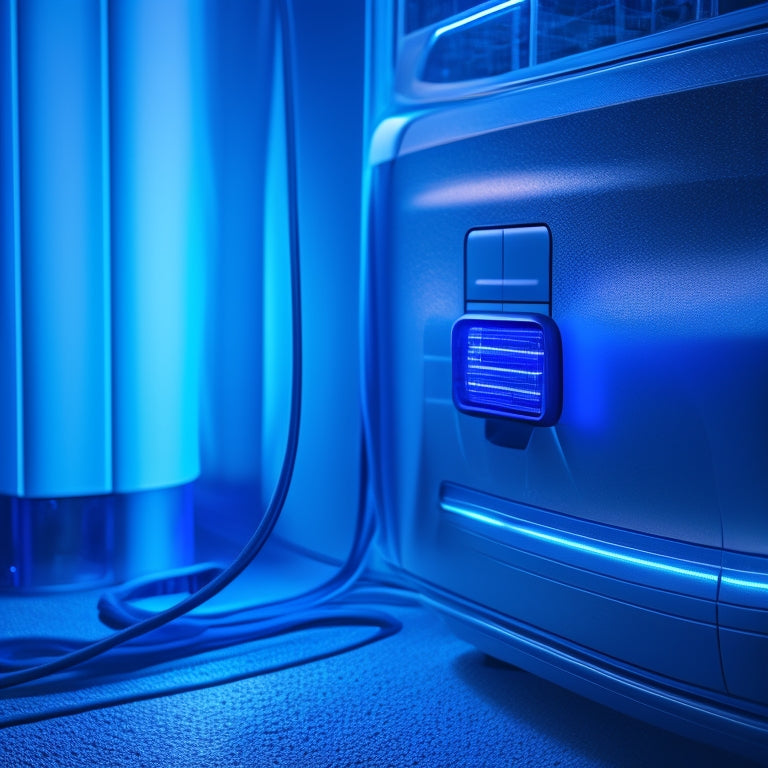
SAE Revolutionizes North American EV Charging Standard
Share
SAE's introduction of the J3400 North American Charging Standard (NACS) revolutionizes EV charging in North America, unifying the continent's disparate charging systems under a single, interoperable standard. This unified standard enables seamless charging experiences, increased access to EV charging, and widespread adoption of electric vehicles. By promoting a cohesive charging ecosystem, NACS facilitates efficient communication between systems, guaranteeing universal access to EV charging. As the industry moves towards a unified standard, the future of EV charging in North America looks promising, with substantial reductions in greenhouse gas emissions and infrastructure costs on the horizon, and more insights await.
Key Takeaways
• SAE J3400 standard unifies EV charging in North America, enabling seamless charging experiences for EV drivers across the continent.
• The open and interoperable standard guarantees universal access to EV charging, facilitating seamless communication between systems.
• The SAE J3400 standard reduces infrastructure costs by eliminating separate circuit panels and transformers, and optimizing electrical efficiency.
• The standard's cost efficiency and charging versatility promote widespread adoption of electric vehicles, driving a shift towards a cohesive charging ecosystem.
• As a result, the SAE J3400 standard is revolutionizing North American EV charging, supporting a future of increased EV adoption and reduced greenhouse gas emissions.
Unifying EV Charging in North America
The SAE J3400 North American Charging Standard (NACS) is poised to revolutionize electric vehicle (EV) charging in North America by providing a unified connector for EVs and charging stations, thereby guaranteeing increased access to EV charging across the continent.
This standardized approach enables seamless charging experiences for EV drivers, promoting widespread adoption of electric vehicles. Standardized connectors guarantee that any EV can charge at any station, eliminating the need for multiple adapters or proprietary connectors.
Importance of Interoperable Standards
Gabe Klein emphasizes that open and interoperable standards are vital for guaranteeing universal access to EV charging, as they facilitate seamless communication between different systems and promote a cohesive charging ecosystem.
Interoperable standards are indispensable for achieving universal accessibility, allowing every electric vehicle (EV) to charge at any station. This seamless integration ensures that EV drivers can charge their vehicles effortlessly, regardless of the charging station or network.
Benefits of SAE J3400 Standard
By standardizing the connector and communication protocol, the SAE J3400 facilitates cost-effective mass electrification of transportation, providing a unified solution for both AC and DC charging. This standard enables charging versatility, allowing for smooth shifts between different charging types. The benefits of SAE J3400 are multifaceted:
| Benefits | Description |
|---|---|
| Cost Efficiency | Reduces infrastructure costs by eliminating the need for separate circuit panels and step-down transformers |
| Charging Versatility | Enables charging in various settings, including parking garages, with AC power transfer |
| Unified Solution | Provides a single connector for both AC and DC charging, streamlining infrastructure setup |
| Increased Efficiency | Optimizes charging efficiency, reducing the need for additional equipment |
Infrastructure Cost Savings Enabled
Standardization of the SAE J3400 connector and communication protocol enables infrastructure cost savings by allowing the use of same utility power feeds for DC fast charging and single-phase AC charging. This unified approach eliminates the need for separate circuit panels and step-down transformers at charging sites, reducing infrastructure costs. The cost efficiency of this approach is further amplified by the ability to streamline infrastructure setup and reduce the need for additional equipment.
Here are three key benefits of this standardized approach:
-
Reduced infrastructure costs: By using the same utility power feeds for both DC fast charging and single-phase AC charging, the need for separate equipment is eliminated, resulting in cost savings.
-
Electrical optimization: The standardized infrastructure setup enables higher efficiencies in charging, reducing energy losses and promoting a more efficient charging experience.
-
Streamlined infrastructure setup: The use of a single connector for different charging types simplifies the infrastructure setup, reducing installation time and costs.
Future of EV Charging in North America
As the SAE J3400 standard revolutionizes the North American EV charging landscape, it sets the stage for a future where EV charging becomes increasingly accessible, efficient, and widespread across the continent. This future is driven by technological advancements, shifting consumer behavior, and supportive government incentives.
As EV adoption grows, the environmental impact of transportation will notably decrease, contributing to a cleaner and healthier environment. The SAE J3400 standard paves the way for a seamless and efficient charging experience, fostering confidence in EV owners and encouraging further adoption.
As the charging infrastructure expands, we can expect to see a substantial reduction in greenhouse gas emissions, ultimately contributing to a more sustainable future for North America.
Frequently Asked Questions
Will SAE J3400 Replace Existing Charging Connectors in the Market?
As SAE J3400 gains traction, industry impact will be significant, with a gradual phase-out of existing connectors, while consumer reaction will be mixed, with some embracing the standardized connector and others resisting change.
Can I Use My Current EV Charger With the New SAE J3400 Standard?
While your existing EV charger may not be obsolete, seamless integration with the SAE J3400 standard may require adapter compatibility, ensuring a harmonious shift, but it is crucial to verify charger compatibility to guarantee uninterrupted charging experiences.
How Long Will It Take for SAE J3400 to Be Widely Adopted in North America?
The widespread adoption of SAE J3400 in North America is contingent upon infrastructure readiness and overcoming regulatory hurdles, with a projected timeline of 3-5 years for broad implementation.
Will the SAE J3400 Standard Be Adopted Globally or Only in North America?
As the SAE J3400 standard sets a precedent for seamless charging, its Global Impact will likely inspire International Cooperation, fostering a unified, universal charging ecosystem that transcends geographical boundaries.
Can I Charge My Tesla With the SAE J3400 Connector at Any Charging Station?
With the SAE J3400 standard, Tesla owners can expect seamless compatibility, alleviating charging anxiety, as the standardized connector enables hassle-free charging at any compatible station, ensuring a unified and convenient charging experience.
Related Posts
-

3 Best Solar-Powered Biodegradable Accessories for Your Home
You're taking a significant step towards a more sustainable lifestyle by incorporating solar-powered biodegradable ac...
-

Why EVs Inspire Earth-Conscious Home Design Choices
As you shift to an electric vehicle, you're not just switching to a greener ride, you're igniting a broader commitmen...
-

7 Blockchain Tools for Home Energy Management
You can utilize blockchain technology to optimize your home's energy management through innovative solutions like blo...


